Got a few pics of your setup?Strange coincidence, I have just fitted a very similar circuit between the leisure +ve and the starter +ve on my T6.
I have a fuse (7Amp) a diode (rated @ 10Amps) and a 55W spotlight bulb. The 55W bulb is to limit the current drawn should the starter battery be very low and I try to start the van. I think the trickle charge from leisure to starter is about 1.0Amp when the solar has the leisure up over 13.5v and the starter is down below 12v, obviously that drops rapidly as the voltage difference between the two batteries approach the forward volt drop figure across the diode.
However the figures work out this seems to keep the starter battery topped up during the periods of non-use. Outside the current lock-down this will never occur as the vehicle is used regularly so this bit of circuit may well be removed eventually.
Cost to me having all but the diode to hand was 85p!
You are using an out of date browser. It may not display this or other websites correctly.
You should upgrade or use an alternative browser.
You should upgrade or use an alternative browser.
trickle charging starter battery & Psu modification
- Thread starter Lowlec
- Start date
lol . . .I just wish I understood even a little bit of all this.
well, today is the day you can begin learning . . . . . .
start here -->
.
You could certainly buy the components for cheaper. You could also certainly DIY one, although I assume you'd only do this if you enjoyed it as a hobby, I can't imagine anyone actually valuing their time so cheaply that they'd build one themselves rather than shell out £27! Personally, I'd quite happily pay £27 to remove the worry that my starter might go flat every time the van is left for a bit, or for extended wild camping.
Having read about the Votronics unit in this thread I built my version of it into the cupboard at the back of the van.
I did this as (a) I enjoy it, (b) I can and (c) I'm retired! Just added a low voltage cut-off module which I had lying around in case the van battery tries to take too much out of the leisure one. And a couple of LEDs on the worktop side of the cupboard to show when it's charging and if the low voltage cut-off has been reached. PTC fuse to be added too, but hasn't arrived yet.
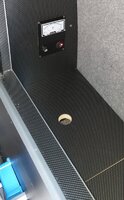
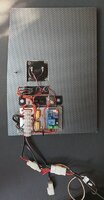
Got a few pics of your setup?
It's not elegant and was never meant to be but it's safe and does the job as far as tests have shown yet. The components actually tuck out of sight under the fuse boards within the box which has a clear screwed down lid. The whole thing is on extended looms and slides under the left front seat from the rear.
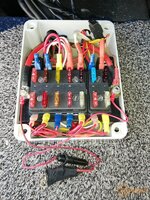
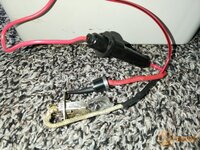
Circuit diagram...
It's not elegant and was never meant to be but it's safe and does the job as far as tests have shown yet. The components actually tuck out of sight under the fuse boards within the box which has a clear screwed down lid. The whole thing is on extended looms and slides under the left front seat from the rear.
View attachment 71257
View attachment 71258
Circuit diagram...
View attachment 71259
side post . . . . . . .
love it.
well done.
mind me asking why a 55W bulb instead of a power resistor?
and
whats the max Amps it will pass?
and whats the diode spec? and forward volt drop across it?
The bulb - because it was in a box in the garage.
A 55W bulb will drop 12v across it when passing 4.5A. I didn't bother to work any of it out, just put the circuit together first of all with a 21W bulb an nominally saw a trickle of about 0.4A then upped the bulb type to the old 55W halogen and saw a trickle of around 0.9A to 1A.
The diode spec is dubious, it was this eBay item 272689955724 and probably from China imported by the thousand.
The fuse & fuse holder - again because it was in a box in the garage,
As you can see there was no serious technical design, it was simply scratch built at the vast cost of 85p, what had I got to loose?
If you hear no more about this assume it works successfully over time, I'll let you know if I have to change or remove it.
A 55W bulb will drop 12v across it when passing 4.5A. I didn't bother to work any of it out, just put the circuit together first of all with a 21W bulb an nominally saw a trickle of about 0.4A then upped the bulb type to the old 55W halogen and saw a trickle of around 0.9A to 1A.
The diode spec is dubious, it was this eBay item 272689955724 and probably from China imported by the thousand.
The fuse & fuse holder - again because it was in a box in the garage,
As you can see there was no serious technical design, it was simply scratch built at the vast cost of 85p, what had I got to loose?
If you hear no more about this assume it works successfully over time, I'll let you know if I have to change or remove it.
mind me asking why a 55W bulb instead of a power resistor?
The advantage of a bulb is that it is a PTC (Positive Temperature Coefficient) device. This means its resistance increases with heat; i.e. the more current that is drawn the higher the resistance will go and limit the current at the top end. The worst that can happen with a bulb is that it lights up if the starter battery is very low.
I tried power resistors and all sorts of fancy current limiting circuits. The difference in voltage between the source battery and load battery is too small to allow active circuits to work correctly. A power resistor will get very hot in a low starter battery (high current) scenario. A PTC fuse could prevent this but it will still cycle on and off.
The simple solution is to use a bulb. I just used 2 capless wedge 501 5W bulbs in parallel. That provided enough current to offset any parasitic draw on the starter battery without too much heat if the bulbs were to glow. The box has 2 LED voltmeter displays - one for the source, one for the load. These are switchable otherwise they will use more energy than the parasitic draw. The charging is also switchable so I can use the box for other voltage measuring purposes. A 6A diode in series with the bulbs prevents any reverse charging.
The unit is just temporarily connected between two 12V sockets in the van when parked up for long periods. The 2 plugs are both fused at 2A for additional protection.

The advantage of a bulb is that it is a PTC (Positive Temperature Coefficient) device. This means its resistance increases with heat; i.e. the more current that is drawn the higher the resistance will go and limit the current at the top end. The worst that can happen with a bulb is that it lights up if the starter battery is very low.
I tried power resistors and all sorts of fancy current limiting circuits. The difference in voltage between the source battery and load battery is too small to allow active circuits to work correctly. A power resistor will get very hot in a low starter battery (high current) scenario. A PTC fuse could prevent this but it will still cycle on and off.
The simple solution is to use a bulb. I just used 2 capless wedge 501 5W bulbs in parallel. That provided enough current to offset any parasitic draw on the starter battery without too much heat if the bulbs were to glow. The box has 2 LED voltmeter displays - one for the source, one for the load. These are switchable otherwise they will use more energy than the parasitic draw. The charging is also switchable so I can use the box for other voltage measuring purposes. A 6A diode in series with the bulbs prevents any reverse charging.
The unit is just temporarily connected between two 12V sockets in the van when parked up for long periods. The 2 plugs are both fused at 2A for additional protection.
That's a great bit of kit, I just went for the simplest and cheapest solution as it is really only needed whilst the van is getting minimal use.
I did think of the plug-in idea between two accessory sockets each on different batteries but erred on the side of simplicity.
A very crude method of topping up the starter battery!The advantage of a bulb is that it is a PTC (Positive Temperature Coefficient) device. This means its resistance increases with heat; i.e. the more current that is drawn the higher the resistance will go and limit the current at the top end. The worst that can happen with a bulb is that it lights up if the starter battery is very low.
I tried power resistors and all sorts of fancy current limiting circuits. The difference in voltage between the source battery and load battery is too small to allow active circuits to work correctly. A power resistor will get very hot in a low starter battery (high current) scenario. A PTC fuse could prevent this but it will still cycle on and off.
The simple solution is to use a bulb. I just used 2 capless wedge 501 5W bulbs in parallel. That provided enough current to offset any parasitic draw on the starter battery without too much heat if the bulbs were to glow. The box has 2 LED voltmeter displays - one for the source, one for the load. These are switchable otherwise they will use more energy than the parasitic draw. The charging is also switchable so I can use the box for other voltage measuring purposes. A 6A diode in series with the bulbs prevents any reverse charging.
The unit is just temporarily connected between two 12V sockets in the van when parked up for long periods. The 2 plugs are both fused at 2A for additional protection.
View attachment 71339
The victron dc/dc, control charges The starter battery,with current indication Proper heat dissipation and no parasitic drain on the leisure battery as such.
People spend thounsands on their VW T6’s and resort to things like this!..
...just saying saying!
Last edited:
Just to lower the tone a bit further...my solution i think has to be the simplest and cheapest, however does require some consideration when to use.
2 fused cigarette lighter plugs back to back via a length of wire and a diode in the back of one of the plugs. Where is the current limiting resistor i hear you ask!?! - there isn't one...i just only plug it in when the starter battery is charged (thus at a similar level to the leisure battery, which due to solar is always full) and therefore is used to maintain the starter battery and not charge it, offsetting the parasitic drain whilst its sitting on my drive going nowhere for weeks on end.
This was really only meant to be an 'experiment' until i could get my hands on a power resistor of which I've 100's at work...however never evolved further.
Worst case is if i plug in the cable when the starter battery is flat and an imbalance in voltages one of the 2A fuses will blow however the cable and diode are rated well in excess of the fuses.
Long term i plan to change the solar charge controller to a unit with a 2nd output, but until now and during Covid..the above is working fine.
2 fused cigarette lighter plugs back to back via a length of wire and a diode in the back of one of the plugs. Where is the current limiting resistor i hear you ask!?! - there isn't one...i just only plug it in when the starter battery is charged (thus at a similar level to the leisure battery, which due to solar is always full) and therefore is used to maintain the starter battery and not charge it, offsetting the parasitic drain whilst its sitting on my drive going nowhere for weeks on end.
This was really only meant to be an 'experiment' until i could get my hands on a power resistor of which I've 100's at work...however never evolved further.
Worst case is if i plug in the cable when the starter battery is flat and an imbalance in voltages one of the 2A fuses will blow however the cable and diode are rated well in excess of the fuses.
Long term i plan to change the solar charge controller to a unit with a 2nd output, but until now and during Covid..the above is working fine.
Lol... I like it.
I'll start a new thread and move these mod over there....
Plus I have something in the pipeline that's a more suitable fix for the people who dont feel comfortable with the electronics.
I'll start a new thread and move these mod over there....
Plus I have something in the pipeline that's a more suitable fix for the people who dont feel comfortable with the electronics.
A very crude method of topping up the starter battery!
The victron dc/dc, control charges The starter battery,with current indication Proper heat dissipation and no parasitic drain on the leisure battery as such.
People spend thounsands on their VW’s and resort to things like this!..
...just saying saying!
I've spent thousands on this VW and it could still be considered as crude but it's still going after 74 years!
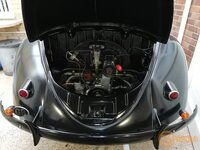
6 volt electrics, no syncromesh, cable brakes and I'm still happy to drive it to Germany to events.
I've spent thousands on this VW and it could still be considered as crude but it's still going after 74 years!
6 volt electrics, no syncromesh, cable brakes and I'm still happy to drive it to Germany to events.
sometimes the simplest solutions are the best, more to the point if you understand whats going on yourself..you can keep things ticking along nicely

Sorry.
l know this is an old thread.
But, would the following item, work the same way as the Voltronic does, for charging the starter battery when the vehicle is on EHU and the leisure battery is full?
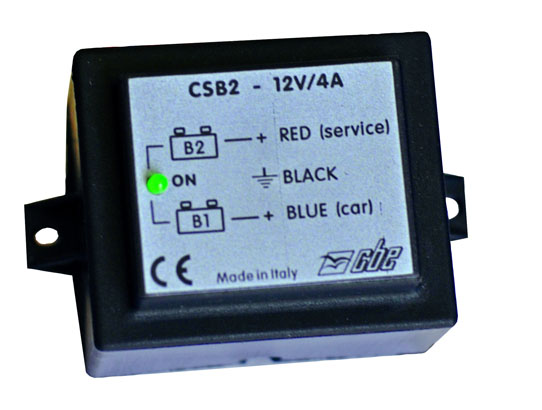
Thanks
l know this is an old thread.
But, would the following item, work the same way as the Voltronic does, for charging the starter battery when the vehicle is on EHU and the leisure battery is full?

Thanks
I've not come across that one....
I've have a look at the specs.
More information here;

 www.t6forum.com
www.t6forum.com
.
I've have a look at the specs.
More information here;

[Guide] Battery Maintainer (for Starter battery) -- How I Done It --
[Guide] Battery Maintainer (for Starter battery) -- How I Done It -- Right so its that time of year again . . . . . . . . Winter & (Lockdown 2020) The van might be layed up not being used, which will lead to a flat battery in around 3 weeks. The cold weather doesn't help the battery's...
.
would the following item, work the same way as the Voltronic does
It looks very similar if not the same as the Voltronic. It certainly has the same functionality and will keep your starter battery topped up from the leisure battery.
Last edited:
I've just added to a six year old thread on the Motorhome Fun Forum asking users for their comments on the CSB2.
See Best place to wire in CSB2 split charger
Maybe someone will comment.
See Best place to wire in CSB2 split charger
Maybe someone will comment.
Similar threads
- Replies
- 4
- Views
- 441
- Replies
- 8
- Views
- 290
- Replies
- 42
- Views
- 1K
- Replies
- 13
- Views
- 888
